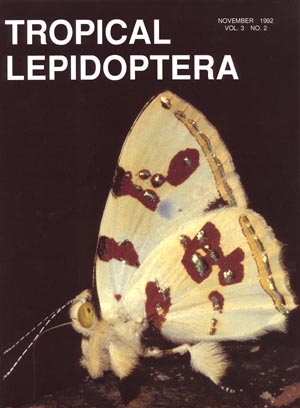Life history of <i>Anetia briarea</i> and its bearing on the evolutionary relationships of the Danainae (Lepidoptera: Nymphalidae).
Schlagworte:
Amauris, Apocynaceae, Asclepiadaceae, behavior, biogeography, Central America, chemical defense, Danaina, Danaini, Danaus, Dominican Republic, Euploea, Euploeina, Euploeini, evolution, Greater Antilles, Hispaniola, hostplants, Idea, Ideopsis, immature stages, Ithomiinae, Itunina, larval morphology, Lycorea, Lycoreini, Mexico, milkweed butterflies, Neotropical, Parantica, parasites, Pinaceae, Protoploea, pupa, Taiwan, taxonomic characters, Theophrastaceae, Tirumala, West IndiesAbstract
Wild captured Anetia briarea females oviposited on, and their larvae ate, Cynanchum angustifolium, a milkweed vine (Asclepiadaceae). Contrary to the early literature, 2nd through 5th instar larvae bear a pair of well developed dorsal tubercles on their mesothorax. This and several other larval and chrysalid characters question Ackery and Vane-Wright's (1984) placement of the genus Anetia in the largely Old World tribe Euploeini, as well as its relationship to the genus Lycorea. Several larval and chrysalid characters seem closer to those of the tribe Danaini. Forbes (1939) may well have been correct in placing Anetia at the base of the subfamily Danainae. The new findings have major evolutionary and taxonomic implications for the milkweed butterflies.Downloads
Veröffentlicht
1992-11-01
Ausgabe
Rubrik
Articles

